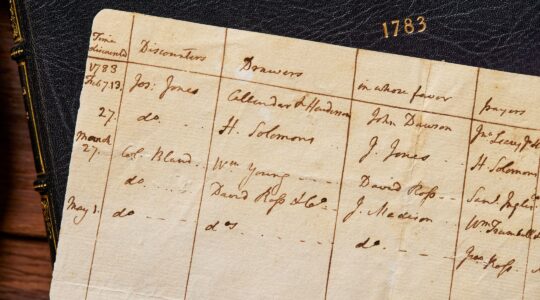In May 1977, JTA announced that it would put all of it’s old articles onto 16mm microfilm. 35 years later, JTA is celebrating the one year anniversary of our online Jewish news archive.
Here’s a look at 10 great JTA tech innovations, in no particular order:
- 10. Daily News Bulletin put on microfilm (1977)
More than 30 years later, this decision provided the source material for the online JTA Archive:NEW YORK, May. 17 (JTA) – To make the Jewish Telegraphic Agency Daily News Bulletin available to students and scholars of contemporary Jewish history, the JTA has put its daily news reports beginning with 1922 on microfilm.
In making this announcement, William M. Landau, president of the JTA, stated that "microfilming these valuable records will fill a gap in the material available to those studying contemporary Jewish history from the pre-Hitler era through World War II, the founding of the State of Israel, to the present. This is another example of JTA’s service to the Jewish community at large." Each year of the Daily News Bulletin is on one 16 mm microfilm roll.
[[READMORE]] - 9. Eh-xit polls: Instant Israeli election results (1981)
Statistician Hanoch Smith was to 1977 what Nate Silver was to 2008. Smith’s ‘Duplicare’ method yielded successful predictions for the 1977 Israeli elections, which JTA hired him to replicate in 1981. The secret sauce:Voters emerging from the official polling stations will be asked to repeat their vote, in secret, in the "dummy" booth. The latter will close at 7 p.m. The "dummy" results will be computed by [statistician Hanoch] Smith and his aides and adjusted statistically for the percentage of voters who cast their ballots as of 7 p.m. This corresponds to 1 p.m. New York time.
- 8. First U.S. facsimile circuit designed for the transmission of news copy (1955)
Designed for Yiddish-language newspaper clients, JTA was inspired to have Western Union design this technology after the technology was pioneered in Japan:The new circuit links the New York headquarters of the Jewish Telegraphic Agency with the editorial offices of the Jewish Daily Forward and The Day-Morning Journal. It permits almost instantaneous reception of the JTA news service specially prepared and translated into Yiddish for the Jewish press.
- 7. Not radio ‘ham’– just piggybacking (1924, 1930)
This wasn’t a technological innovation so much as piggybacking off of existing programs. But before podcasts were fashionable, JTA found ways to have their material heard weekly via airwaves in 1924 and 1930:News of the current events of Jewish life from all over the world, gathered by the Jewish Telegraphic Agency, are being broadcasted every Wednesday evening from WEAF, the American Telephone and Telegraph Co’s station, the most powerful station on earth, atop their own skyscraper. The J. T. A. radio news service is a part of the regular weekly program broadcasted every Wednesday night by the United Synagogue of America.
By virtue of a new arrangement just entered into, a specially prepared weekly summary of Jewish news furnished by the Jewish Telegraphic Agency will be broadcast every Sunday at 6 P. M., over the radio hour of Young Israel through Station WPCH.
- 6. First trans-oceanic transmission of Hebrew-language alphabet in radio news communications (1960)
While conceding that transmission time would be slower, added language features were deemed to be worth the cost:Previously, Israeli newspaper correspondents wrote their dispatches in a transliterated Hebrew, using English characters to represent the Hebrew sounds. Israeli correspondents stationed in the United States will now be able to write their messages in Hebrew for transmission in the Hebrew alphabet. The Hebrew copy is transmitted on facsimile equipment in the JTA New York office over Press Wireless transmitters. The signals are received by the Israeli News Agency’s radio station in Tel Aviv and converted into printed copy there on facsimile reception equipment.
- 5. JTA upgrades Rio de Janeiro, Tel Aviv to radio printer circuits (1955)
Radio circuit upgrades in the helped bring news organizations in South America and Israel out of the stone age that was morse code: - 4. Direct U. N. line opened (1954)
While U.N. Headquarters were practically in JTA HQ’s New York City backyard, this innovation helped JTA keep an ear to the door of international affairs:The line is connected with the UN loud speaker system and enables the JTA editor to listen to the actual proceedings in the Security Council and other UN bodies, thus making it possible to summarize speeches speedily and transmit them to JTA offices throughout the world with a minimum loss of time.
The service was upgraded in 1960
- 3. JTA Bulletins smuggled in Poland
The details are sparse and whether or not JTA was involved isn’t known from this report. Still, interesting development in Nazi-occupied Poland one year after the Warsaw Ghetto uprising:News bulletins issued by the Jewish Telegraphic Agency in London, which give a comprehensive picture of Jewish life in the United States, Palestine and other countries, are being sent by the Polish Government to the Jewish underground movement in Poland through secret channels.
- 2. JTA joins the World Wide Web (1996)
Enjoy the 90’s website screen shot:

- 1. JTA enters computer age (1979)
A typewriter CONNECTED TO a screen? Mock the arrival of computers in 1979 if you must. But remember: you’re only a generation away from being mocked for double-clicking a mouse:JTA operators now type stories on an ultramodern electronic terminal which combines a TV screen and a typewriter keyboard, stores articles on a floppy disc and at any appropriate time transmits them via telephone to a computer in Reuters New York data center.
The New York-Rio radio printer circuit replaces manually received transmissions in Morse code by automatic transmission and reception. Louis P. Rocker, president of JTA, described the new circuit as the first step in the mechanization of the JTA service to Latin America. Present plans, he said, provide for extension of the printer service during 1955 to all other JTA bureaus in Latin America. These bureaus are now receiving the JTA service by Morse code.
In 1964, the technology was extended to other JTA clients in South American clients. Israel got another radio printer circuit upgrade in 1968 to triple its output.
JTA has documented Jewish history in real-time for over a century. Keep our journalism strong by joining us in supporting independent, award-winning reporting.





